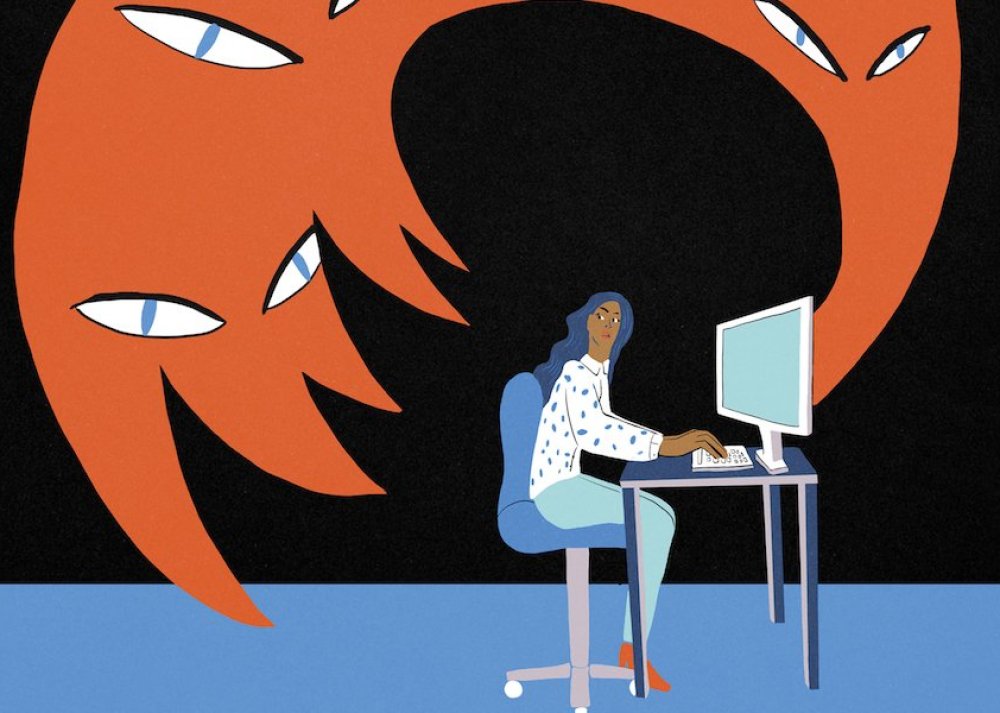
Introduction
Nearly two months into Israel’s full-scale aggression against Lebanon, the country faces a catastrophic toll: until this day 3,445 lives lost, over 14,599 injured, and nearly 1.5 million displaced. Lebanon now stands at an unprecedented level of internal polarization, unseen in its recent history. While all Lebanese factions agree on the urgent need for a ceasefire, deep divisions have emerged over Hezbollah’s military and diplomatic strategy. These divisions were further fueled by controversial statements from Iranian officials, urging the Lebanese population to show greater resilience amid the ongoing conflict. Such statements, often echoed by Hezbollah officials in communications with their supporters, have provoked widespread outrage among the larger Lebanese public. This rhetoric has exacerbated polarization, fostering hostility and hate in an already volatile digital landscape.
This report, continuing the Samir Kassir Foundation’s commitment to monitoring and addressing violations of freedom of expression, critically evaluates social media sentiment and conducts network analysis to examine the surge of online attacks against journalists and media personnel. Using a robust analytical framework, the study investigates contributors’ stances toward victims of these violations, the prevalence of hate speech, and the political affiliations underpinning this divisive discourse.
Context
On Saturday, October 19, 2024, Syrian-Lebanese journalist and Deputy Editor-in-Chief of NOW Lebanon, Alia Mansour, was arrested by Lebanese State Security during a raid on her Beirut home. Acting under a judicial order from Investigative Judge Claude Ghanem, her detention stemmed from a fake social media account using Mansour’s photo to post a reply engaging with an Israeli public figure. Although Mansour was released hours later, her electronic devices and passport remain confiscated. In an interview with Al-Hadath TV, Mansour explained that as a journalist with dual Syrian and Lebanese citizenship, she is entitled to the rights of both countries. She stated that the controversial comment—widely circulated via a screenshot—was not made by her. To counter the misinformation, she posted the screenshot on her verified account to clarify that the account in question did not belong to her.
Mansour expressed shock at the swift response by Lebanese security agencies, which obtained an arrest warrant within 24 hours—an unusually rapid action given Lebanon’s broader instability. She also criticized the 6:30 AM raid on her home, citing the distress caused to her young children. According to Mansour, such invasive measures are typically reserved for drug-related cases or fugitives, not journalists exercising their right to free expression. Her passport and laptop remain confiscated.
Two days later, on Monday, October 21, 2024, journalist Dima Sadek disclosed on X (formerly Twitter) that she and her children had been receiving daily death threats via social media and her private phone number. Sadek linked these threats directly to her political opinions, which she regularly shares on the platform.
The Samir Kassir Foundation (SKF) reported both incidents on October 20 and 22, 2024, respectively, via its website and social media channels. This report analyzes the 200 most recent comments on each of the corresponding Facebook posts to identify trends in sentiment, hate speech, and political affiliations. Furthermore, the report presents evidence of similar campaigns targeting other media professionals, including journalists Nabil Mamlouk, Iman Chweikh, and Hisham Haddad, underscoring the systemic nature of these digital threats.
Analysis of Social Media Comments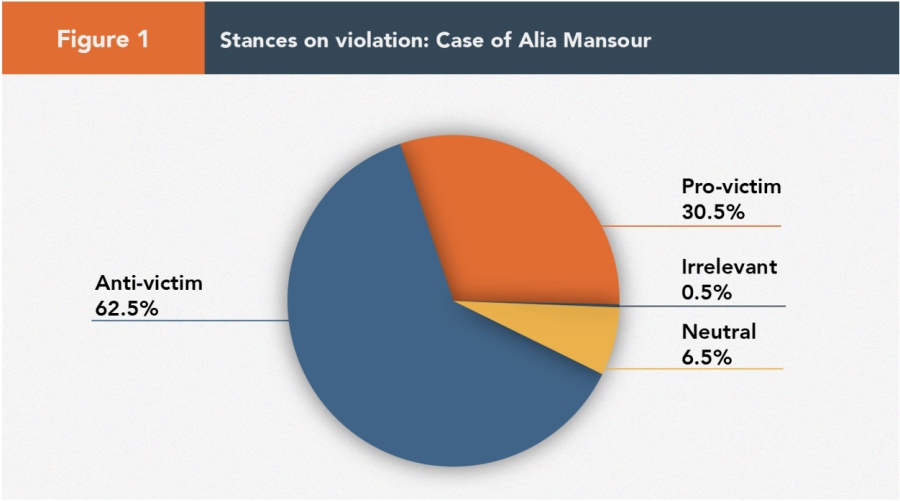
An analysis of two datasets comprising interacting comments revealed sharp polarization in public sentiment toward Alia Mansour. Among the analyzed comments, 30.5% expressed solidarity with Mansour, often dismissing the accusations against her as baseless and framing Hezbollah as harboring the true collaborators. Conversely, 62.5% opposed her, calling for her prosecution. These negative reactions largely stemmed from her outspoken anti-Hezbollah views and her support for the Syrian revolution, which critics attempted to frame as contradictory to the Palestinian cause. Meanwhile, 6.5% adopted a neutral stance, and one comment was classified as irrelevant to the issue.
Img 01. Comments reflecting xenophobic and violent incitement against Alia Mansour

The analysis revealed a troubling prevalence of hate speech, with 38% containing hateful references. Notably, nearly 60% of the comments condemning Mansour included various forms of hate speech, ranging from calls for execution to threats of physical and sexual violence. Among the most egregious comments were those advocating for Mansour’s deportation to Syria, dismissing her as “not a real Lebanese citizen” due to her Syrian origins. These remarks often made reference to the Syrian regime’s brutal methods for dealing with alleged collaborators and its notorious history of torture and abuse in prisons. Others accused Mansour of encouraging Syrian refugees to settle in Lebanon as part of a supposed agenda for demographic change—a narrative previously weaponized in hate campaigns targeting Syrian refugees in Lebanon.
Img 02. Derogatory insults inciting sexual violence and killing of Alia Mansour

The polarization surrounding Dima Sadek was even more pronounced. Only 20% expressed solidarity with her, often attributing the systematic attacks she faced to her commitment to uncovering and sharing the truth. In stark contrast, 80% denounced Sadek, with many accusing her of fabricating the threats as part of a publicity stunt.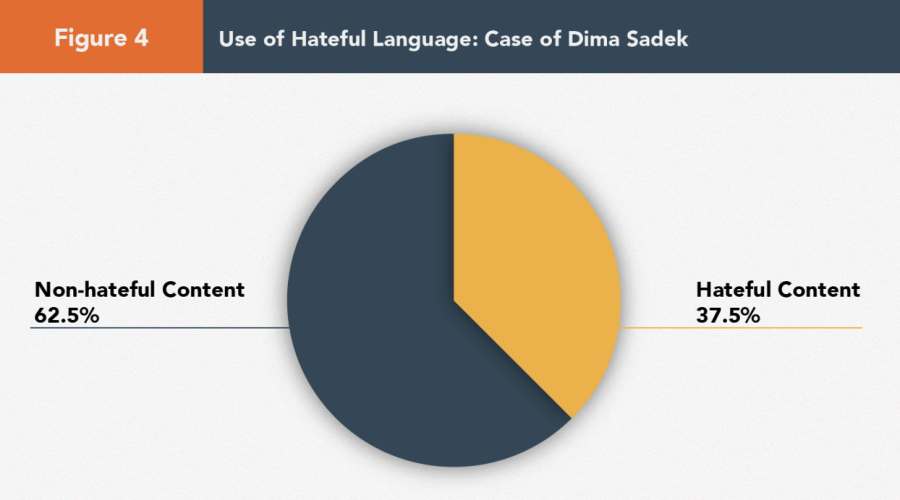
The findings on hate speech directed at Dima Sadek were equally alarming, with 37.5% containing hateful content. Nearly 47% of the comments denouncing Sadek included hate speech, with calls for physical and sexual assault alongside demands for her execution.
A particularly troubling phenomenon emerged within these interactions: mass replies targeted at users who expressed solidarity with Sadek. These replies were saturated with derogatory and hateful language, aimed at intimidating and silencing her supporters. Although these replies were not included in the primary dataset for Sadek, their widespread occurrence highlights the orchestrated nature of digital bullying campaigns.
Img 03. Targeted bullying and derogatory insults against comments that expressed Solidarity with Dima Sadek
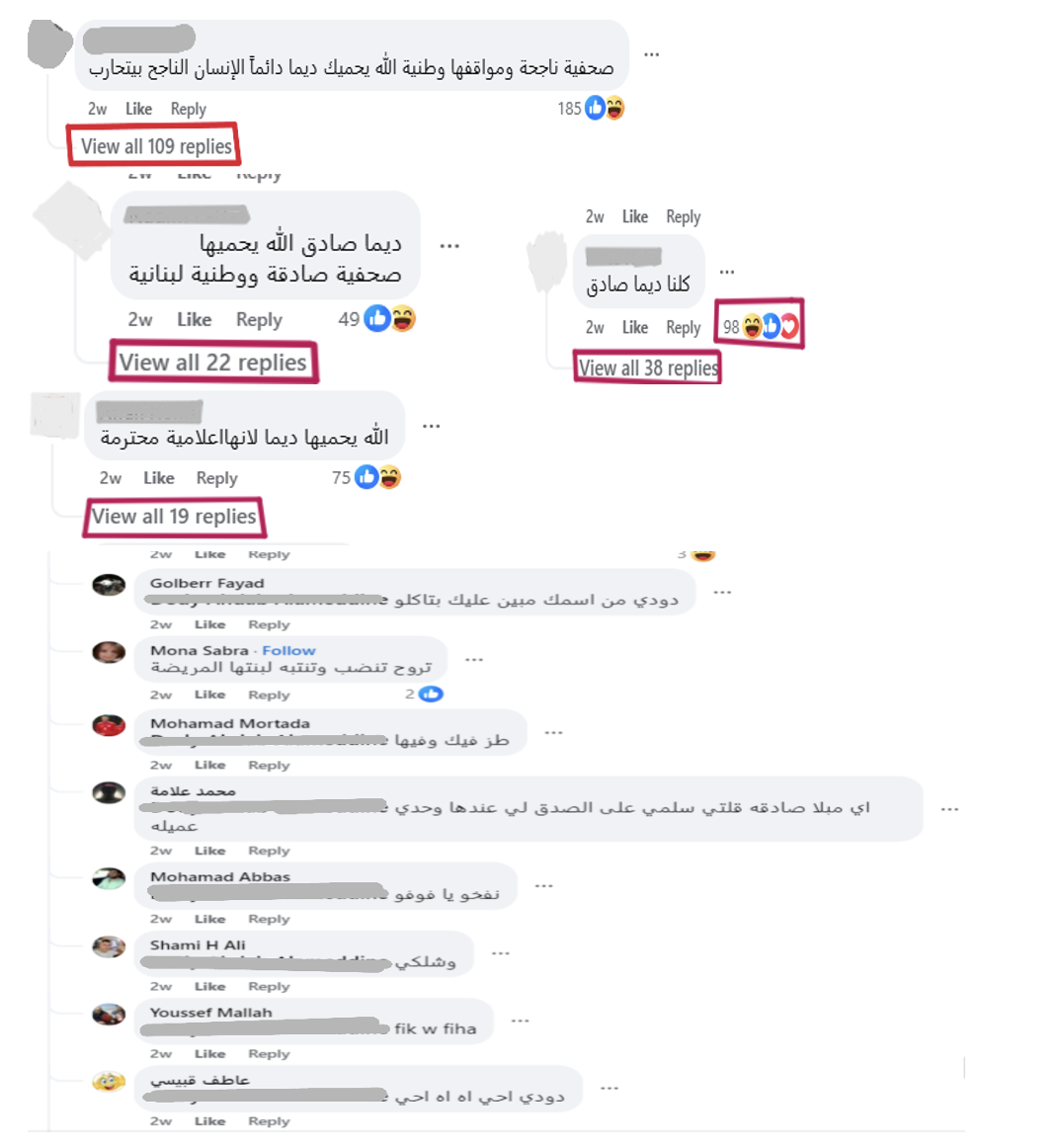
Img 04. Comments inciting sexual violence against Dima Sadek


A breakdown of the political affiliations of commenters in Mansour’s dataset reveals distinct patterns:
Additionally, the sample included 155 comments from users without a clear political affiliation. Among these, 53 expressed pro-victim stances, 90 were against Mansour, with 56 of these using hate speech similar to the rhetoric observed in comments from Hezbollah-affiliated users. Eleven were neutral.
This analysis underscores the alignment between political affiliations and the prevalence of hate speech, reflecting broader patterns of polarization in the discourse surrounding Alia Mansour.
Sadek’s sample reflected similarly polarized political affiliations:
As in Alia Mansour’s case, a significant portion of comments (122) came from users without a clear political affiliation. Among those, 34 expressed pro-victim stances, 88 opposed Sadek, with 39 of these comments including hateful content, and 11 remained neutral.
This analysis highlights a deeply troubling pattern of targeted harassment and hate speech, driven by political affiliations and ideological divides. It underscores the urgent need for immediate official action to address the digital threats faced by journalists and media personnel in Lebanon.
The cases of Alia Mansour and Dima Sadek highlight the pervasive and possible coordinated nature of digital harassment and incitement, still, they also raise a far more concerning question: Can online threats escalate into real-world violence? While our previous reports highlight several cases where such campaigns escalated to real-life violence, we now aim to explore how the political sensitivity of operating in a warzone can further amplify the degree of contagion of digital violence against journalists.
In what follows, we examine the timeline of events leading to the violent attack on An-Nahar journalist Nabil Mamlouk, an explicit example of how online hate campaigns can transform into direct, life-threatening assaults. By documenting this case, we aim to debunk the misleading narratives weaponized on social media platforms to justify the violence, shedding light on the grave implications for press freedom and personal security.
On the Attack Against Journalist Nabil Mamlouk
On Wednesday, November 13, 2024, freelance journalist Nabil Mamlouk, a contributor to An-Nahar and other media outlets, was violently assaulted in Tyre by a group of men in what appeared to be a premeditated attack. The assailants not only beat Mamlouk severely but also fired live gunshots inside his father’s pharmacy, where he was working at the time. The incident was directly linked to a news update Mamlouk had shared on his Tyre News WhatsApp group, warning residents about an Israeli drone crash and urging them to avoid gathering at the site for their safety.
Recounting the incident to SKF’s SKeyes Center, Mamlouk shared:
“I posted on my WhatsApp news page, Tyre News, that an Israeli drone had crashed nearby and advised people not to gather at the site for their safety. Shortly after, while I was at my father’s pharmacy in Tyre, where I often work on my journalistic and literary projects, around 30 people stormed in and started beating me severely. When I grabbed a razor blade to defend myself, one of them pointed a gun at me but ended up firing three shots into the ceiling of the pharmacy after a family member restrained the shooter. They then took my phone and personal laptop, placed them in a bag, and left.”
Mamlouk refused to leave the pharmacy until a representative of the Amal Movement intervened and returned his belongings. Later, three men present during the attack summoned him to a nearby café. There, one of them confronted Mamlouk, saying, “If you want to keep writing like this, you’d better go and write from Maarab” (the headquarters of the Lebanese Forces).
Mamlouk noted that he did not personally know the attackers but linked the assault to an ongoing wave of incitement against him.
Delving Deeper into the Mamlouk Incident
While some public figures and activists sought to justify the attack as a “spontaneous reaction” to news they claimed could provoke Israeli aggression, records from the SKeyes Center’s violation tracker suggest a pattern of premeditation. Mamlouk had faced explicit threats in the weeks leading up to the assault:
Img 05. Evidence of the final threat Mamlouk received minutes before storming his father’s pharmacy
The incident quickly went viral. By 8:24 PM, it was shared on Instagram by a pro-Hezbollah supporter. The same video surfaced shortly after that on X specifically at 9:16 PM, accompanied by false claims that Mamlouk was an Israeli collaborator transmitting missile coordinates to Israeli forces. This post, originating from a Hezbollah-supporting account based in Baalbek, gained rapid traction.
Img 06. Evidence of the dissemination of propaganda by pro-Hezbollah accounts minutes after the brutal attack against Mamlouk

Coordinated Campaigns
The rapid virality of the video, accompanied by replies calling for Mamlouk’s execution, points to a coordinated effort to justify the assault and potentially pave the way for further escalations. While concrete evidence remains elusive, it is highly suspected that the video’s dissemination on social media might have been bolstered by circulation within specific WhatsApp newsgroups known for amplifying propaganda narratives and disseminating disinformation. This claim is substantiated by evidence of doxing that Mamlouk was subjected to both before and after the attack. Notably, we received documentation of threatening messages sent to Mamlouk’s personal WhatsApp account from anonymous foreign numbers, confirming the circulation of his personal information. These messages were compounded by public calls for his arrest (screenshots attached below).
A prior network analysis conducted by SKF highlighted the influential role of these WhatsApp groups in spreading misleading narratives. In Mamlouk’s case, the false portrayal of him as a collaborator not only incited violence but also normalized threats to his safety in the digital sphere.
This incident exemplifies the dangerous interplay between physical violence and coordinated digital campaigns targeting journalists in Lebanon. It underscores the urgent need for protective measures against such multi-dimensional threats, which jeopardize both freedom of expression and personal safety.
Img 07. Screenshots highlighting the ongoing public and private threats received by Mamlouk

The Politics Behind the Scene
These incidents cannot be fully understood without situating them within Lebanon’s broader political context, marked by growing hostility fueled by inflammatory rhetoric from Hezbollah officials and their affiliates on one side, and a counter-discourse from opposing parties and religious figures on the other. This polarized environment has been exacerbated by public statements from MPs of the Lebanese Forces and the Lebanese Phalangist Party, including fearmongering narratives targeting internally displaced people. Such rhetoric culminated in calls to “free public schools from the displaced,” by Maronite Patriarch Beshara Al Rahi, further amplifying tensions.
Meanwhile, Hezbollah remains uniquely positioned as a “state within a state,” leveraging its power to evade accountability for violence and political assassinations. This dynamic echoes the assassination of prominent Hezbollah critic Lokman Slim, who was targeted following a similarly orchestrated pattern of digital incitement campaigns. In such a volatile climate, threats, violence, and intimidation against journalists have become pervasive, endangering not only their work but also their lives.
On October 22, 2024, now slain Hezbollah spokesperson Mohamad Afif delivered a provocative press conference that openly targeted local and international journalists. Afif’s remarks were rife with accusations and incitement:
“Press freedom doesn’t mean you can incite violence or be complicit in crimes. You push for bloodshed and call it journalism! You fuel conflict from every angle and call it journalism! You provide intelligence to the enemy and call it journalism! Your reports on Al-Qard Al-Hassan, you mouthpieces of corrupt banking interests, are some of your worst work. If you had any sense of decency left—but clearly, that’s wishful thinking. For all your efforts, you truly earned an award, and you got it. Congratulations.”
Similarly, Hezbollah-affiliated MP Hassan Fadlalhah issued veiled threats during a press conference in the Lebanese Parliament:
“When the resistance sacrifices its blood to defend the country against its enemies, it is equally committed to preserving internal peace and national unity. This commitment alone thwarts the goals of those who wish harm upon Lebanon, as well as the opportunists who seek political gain at the expense of the nation. We choose to focus on the positive aspects of patriotic stances and ignore the low-level incitement, fear-mongering, and hate speech. The rumors and provocations circulating here and there will ultimately backfire on their instigators, once the enemy’s plans against our country are defeated.”
While Fadlallah’s rhetoric was more measured than Afif’s, his remarks carried a clear message: dissenters and critics of Hezbollah risk facing serious consequences.
The incendiary rhetoric from Hezbollah officials found an echo in Al-Akhbar, a pro-axis of resistance newspaper. This outlet played a central role in fostering incitement against journalists and media professionals, including comedian and TV host Hicham Haddad, co-founder of Beirut Time, an independent investigative platform.
Haddad faced intense backlash after questioning Lebanon’s involvement in the Gaza conflict during a video commentary. He disclosed the threats he received during an interview with Al-Mashhad TV:
“I received several threats, including messages like ‘glory to the silencer’ and ‘you deserve a bullet.’ I have real concerns about returning to Lebanon, as I currently reside in Dubai. I can’t dismiss these anonymous threats lightly, and I’m doing my best to shield my family and children from this situation. All of this is happening simply because I questioned, in a video, the point of dragging Lebanon into a conflict that has come at such a high cost to the country.”
This case highlights how rhetoric and media amplification contribute to a climate of fear and repression, further endangering journalists who dare to challenge the dominant narrative.
Img 08. Al-Akhbar newspaper joins the campaign against Hisham Haddad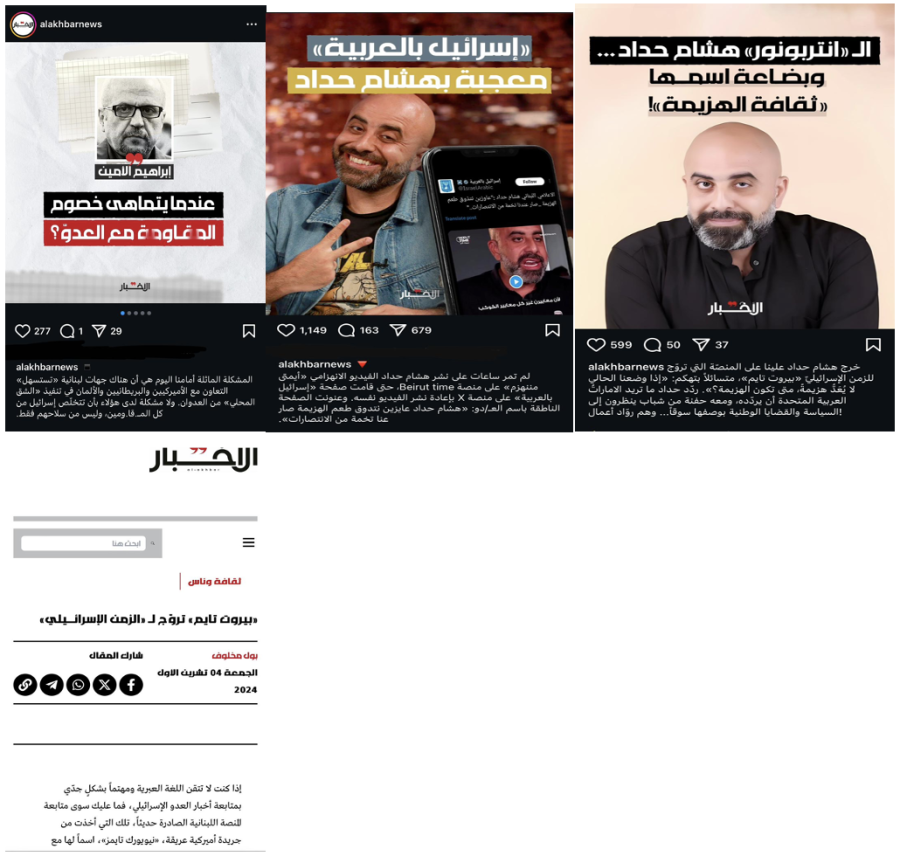
The systematic targeting of journalists was also evident in the case of journalist and TV presenter Eman Shweikh. What began as online incitement escalated into direct threats on her private phone, ultimately forcing her resignation from MTV.
In a public resignation statement shared on X (formerly Twitter), Shweikh wrote:
“I’ve decided to leave MTV due to the escalating threats I’ve been facing, including death threats and harassment that have gone as far as stalking me at my home and following me on the road. My family has also been targeted with intimidation. The state is absent, and the laws have become meaningless. I cannot continue to put my life and the safety of my loved ones at risk. I simply want to live in peace and security. My thanks go to Mr. Michel El Murr, Chairman of MTV.”
This deeply troubling case sets a dangerous precedent, where severe intimidation forced a journalist to relinquish her role and leave her employer.
Img 09. Al-Akhbar’s incitement against MTV and the dissemination of misleading content against Shweikh
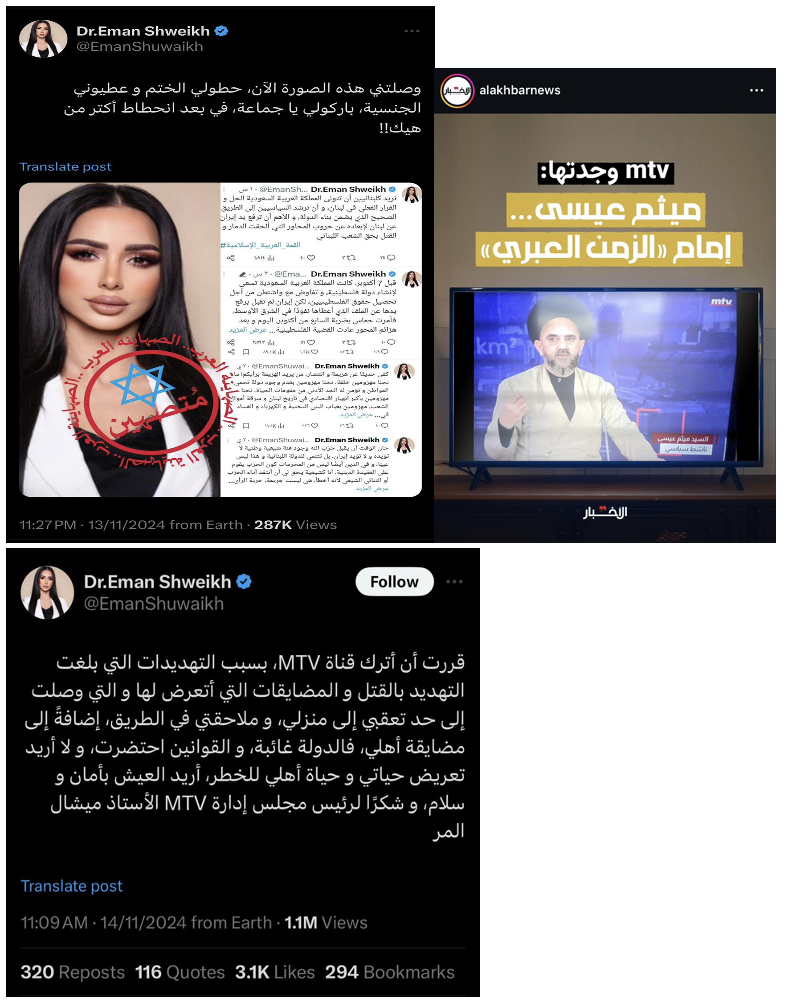
Of the cases discussed, the only notable instance of state intervention occurred in the case of journalist Nabil Mamlouk, who expressed gratitude to the Minister of Information and Lebanese security services for their efforts to safeguard him. While this response is commendable, it stands as an exception in a broader climate where the state has largely failed to protect journalists from threats and violence.
SKF welcomes such interventions and calls on Minister of Information Ziad Makary and the Lebanese security services to establish more effective measures to protect journalists. These measures should include creating robust mechanisms to address threats, ensuring journalists’ safety, and enabling them to carry out their work without fear.
Furthermore, SKF urges Hezbollah officials to reconsider their inflammatory rhetoric, which exacerbates Lebanon’s already fragile security situation. This ongoing incitement not only endangers individual journalists but also normalizes violence, fueling internal divisions and increasing the risk of further bloodshed.
This report is published with the support of the Norwegian Ministry of Foreign Affairs. The contents of the report are the sole responsibility of the authors and do not necessarily reflect the views of the Norwegian Ministry of Foreign Affairs.
